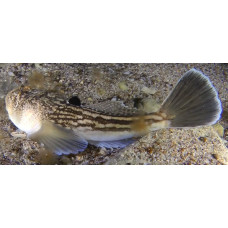Latin name
Uranoscopus scaber
Other names
Uranoscopus scaber
Identification
The body is spindle-shaped. The swim bladder is absent. Its head and jaws are turned upwards and it has a very large mouth. It takes its name from the eyes, which are at the top and close together, and are constantly raised as if to the sky.
Fish colouring
Its body is brown and may have many small pale patches, with a lighter coloured belly.
Distribution
Widespread in the eastern Atlantic, including the Mediterranean.
Habitat
A bottom-dwelling fish, it inhabits sandy or silty-sandy sediments along the upper slope of the continental shelf, at depths of 14 to 400 metres.
Size
Maximum length 40 cm, usually up to 22 cm. Maximum published weight: 940 g. Females are larger than males.
Behavior
It is an ambush predator, hiding under the sand with only its eyes visible. It has a large mouth with a small strip of skin protruding from its lower jaw, which it quickly extends and retracts to act as a lure for prey. When prey approaches, the fish lunges at it, using its specially adapted vertebral column to generate force by bending 60°, taking less than 30 milliseconds to engulf the prey.
Food and feeding habits
It feeds mainly on fish larvae and smaller fish such as gobies, picarelli and small crustaceans, but has also been known to eat molluscs, echinoderms, ringworms, algae and plant material.
Reproduction
It lives for about 5 or 6 years. It spawns between April and September, depending on the region, and lays pelagic eggs about 2 millimetres in diameter. After hatching, the larvae and juveniles remain pelagic. Males are more common than females, but this can vary depending on local populations.
Fishing
Not an economically important fish, mostly caught as by-catch.
Relationship with a person
Has poisonous spines above the pectoral fins behind the gill covers, a danger to swimmers.
| Classification | |
| Phylum | Chordata |
| Class | Actinopterygii |
| Squad | Trachiniformes |
| Family | Uranoscopidae |
| Genus | Uranoscopus |
| Species | U. scaber |
| Features | |
| Conservation status | Least Concern |
| Habitat | Bottom |
| Life span, years | 6 |
| Maximum body weight, kg | 0,94 |
| Maximum length, cm | 40 |
| Sailing speed, m/s | No information |
| Threat to people | Edible |
| Way of eating | Predator |
Atlantic stargazer
Tags: atlantic stargazer



